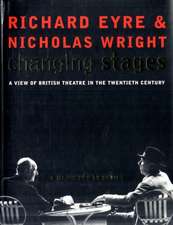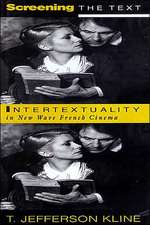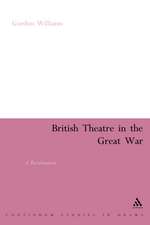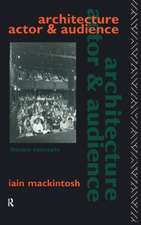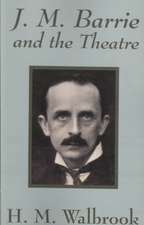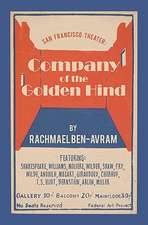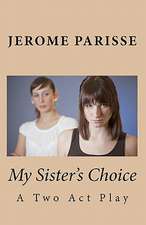Theatre Spaces 1920-2020: Finding the Fun in Functionalism
Autor Iain Mackintosh Cuvânt înainte de Richard Eyreen Limba Engleză Paperback – 5 apr 2023
| Toate formatele și edițiile | Preț | Express |
|---|---|---|
| Paperback (1) | 205.21 lei 3-5 săpt. | +44.97 lei 7-13 zile |
| Bloomsbury Publishing – 5 apr 2023 | 205.21 lei 3-5 săpt. | +44.97 lei 7-13 zile |
| Hardback (1) | 670.71 lei 3-5 săpt. | +26.00 lei 7-13 zile |
| Bloomsbury Publishing – 5 apr 2023 | 670.71 lei 3-5 săpt. | +26.00 lei 7-13 zile |
Preț: 205.21 lei
Preț vechi: 218.57 lei
-6% Nou
Puncte Express: 308
Preț estimativ în valută:
39.27€ • 41.11$ • 32.57£
39.27€ • 41.11$ • 32.57£
Carte disponibilă
Livrare economică 19 martie-02 aprilie
Livrare express 05-11 martie pentru 54.96 lei
Preluare comenzi: 021 569.72.76
Specificații
ISBN-13: 9781350056244
ISBN-10: 1350056243
Pagini: 256
Ilustrații: 80 colour and 51 bw illus
Dimensiuni: 189 x 246 x 16 mm
Greutate: 0.72 kg
Editura: Bloomsbury Publishing
Colecția Methuen Drama
Locul publicării:London, United Kingdom
ISBN-10: 1350056243
Pagini: 256
Ilustrații: 80 colour and 51 bw illus
Dimensiuni: 189 x 246 x 16 mm
Greutate: 0.72 kg
Editura: Bloomsbury Publishing
Colecția Methuen Drama
Locul publicării:London, United Kingdom
Caracteristici
It evaluates the successes and failures of many design projects and distills the architectural design strategies that help actors connect with audiences, including discussions of scale, sight lines, tiered balconies, and the see-and-be-seen qualities of performance spaces
Notă biografică
Iain Mackintosh co-founded the Prospect Theatre Company in 1961, taking 75 productions to over a hundred theatres around the world. He then became a designer of theatre spaces in many countries with Theatre Projects Consultants and has been invited as a guest speaker to conferences across five continents. In 1973 he conceived the design of the National Theatre's Cottesloe space, which opened in 1977. Other spaces which he conceived include Martha Cohen, Calgary, Canada (1985), Orange Tree, UK (1991), Glyndebourne, UK (1994), Lawrence Batley, Huddersfield, UK (1994), The Quays at the The Lowry, Salford, UK (2000), Tina Packer Playhouse, Lenox Massachusetts, USA (2001) and Hall Two of The Sage Gateshead, UK (2004). Renovations in which he was closely involved include de Magd Bergen-op-zoom the Netherlands, Dunfermline Opera House transported to Sarasota Florida, Festival Theatre Edinburgh and Royal Court London, UK. He was the first Briton to serve on the jury of the Prague Quadrennial of Scenography and Theatre Architecture in 1995.
Cuprins
List of IllustrationsForeword by Richard EyreAn Introduction and a SummaryAct 1 Pre-1920: Setting the Scene and Some Early PioneersChapter One: Theatre is Ephemeral While Buildings Endure. Some Necessary BackgroundChapter Two: Richard Wagner, Adolphe Appia and the Spreading of the FanAct II 1920Chapter Three: The Festival Cambridge, Stratford-upon-Avon and Early Days of the NationalChapter Four: Guthrie's Thrust StagesChapter Five: Germany's Building Boom and Anglo-American ShakespeareChapter Six: The Olivier, the Lyttelton and the Barbican TheatresAct III 1976-2020: The Past Informs the PresentChapter Seven: The Cottesloe and Other CourtyardsChapter Eight: Worthy Scaffolds: Brook's Empty Space and Spaces Found by OthersChapter Nine: Regenerating the Old Offers an Antidote to Modernism. Part One: English Theatres of the Eighteenth and Nineteenth CenturiesChapter Ten: Regenerating the old offers an antidote to modernism. Part Two: A Couple of Twentieth-century Scottish Theatres Reborn - One in Edinburgh and the Other in FloridaChapter Eleven: New Opera Houses from Glyndebourne to Dallas. Elsewhere Some Starchitects Upstage the PerformersChapter Twelve: Learning from the Netherlands, Berlin, Brazil, Australia, Indian and Chinese Cultures. The Threat of InternationalismChapter Thirteen: 2010-2020: Some New Builds, Two Renovations - One at Stratford-upon-Avon and One in London - And Diversions on In-the-round and the Open AirAct IV 2021: The FutureChapter Fourteen: Unforeseen Consequences of Seventeenth-century Plagues, of the Arrival of the Talkies and the More Recent Dangers of the Pandemic and of 'Virtual Theatre'. Some Central Themes RestatedReferencesFurther ReadingAcknowledgementsTheatre IndexPerson Index
Recenzii
Superb . if you have a theatre aficionado in your family, this beautifully illustrated, thoroughly opinionated volume ought to be on your list. With six decades of experience to call on, Mackintosh has no end of lessons to pass on.
The virtue of his book is that it is the work of a knowledgeable enthusiast, and proves that, while the play's the thing, the frame in which it is seen is crucial to our enjoyment.
Iain Mackintosh describes his book as a memoir, but it is also a comprehensive handbook for theatre makers and audiences the world over. A one stop shop for anyone interested in how the delicate and vital relationship between audience and performance has evolved over centuries. Upon his shoulders I have stood for 30 years. His argument and understanding is as vital today as it always has been. Essential reading.
Like the man himself, Iain Mackintosh's memoir is erudite, trenchant, occasionally infuriating but always entertaining, enthusiastic and informative. Anyone who wants to understand more deeply the complexities and subtleties of theatre architecture should read this book.
Iain's memoir is a potpourri of historical thesis, personal recollection and entertaining gossip. It gives a glimpse of the theatre world and the agonies and ecstasies of achieving buildings suited to purpose.
This book clears a luminous space of insight at the point where the pragmatics of architecture meet the poetics of the theatrical moment. Iain Mackintosh gleans highly consequential lessons about the challenge of engineering intimacy in the modern theatre auditorium from his long and rich practice. He also grounds them so deftly in their particular, British, history that they begin to acquire a universal appeal. With its stylish writing and generous, well-chosen illustrations this book vivifies and clarifies a theme that has been as elusive as it is important.
A revelatory and much needed guide to the structure of theatres both in Britain and abroad. Iain Mackintosh reveals how certain architectural choices can be traced to having an effect on a performance: for example it's easier to play comedy in a narrow proscenium, very hard to raise a laugh on the wide stages of the Olivier or the Lyttelton, and how crucial it is to the success of a play that it is performed in its correct home. It's an amazingly detailed research of great value to anyone performing on stage today and a necessity for future architects.
A vivid hybrid manifesto/memoir . It is simply an essential book: authoritative, original, comprehensive, compulsively readable, beautifully designed. You can dip in and out; even if you just visit one of these venues casually, you will find this engrossing.
The virtue of his book is that it is the work of a knowledgeable enthusiast, and proves that, while the play's the thing, the frame in which it is seen is crucial to our enjoyment.
Iain Mackintosh describes his book as a memoir, but it is also a comprehensive handbook for theatre makers and audiences the world over. A one stop shop for anyone interested in how the delicate and vital relationship between audience and performance has evolved over centuries. Upon his shoulders I have stood for 30 years. His argument and understanding is as vital today as it always has been. Essential reading.
Like the man himself, Iain Mackintosh's memoir is erudite, trenchant, occasionally infuriating but always entertaining, enthusiastic and informative. Anyone who wants to understand more deeply the complexities and subtleties of theatre architecture should read this book.
Iain's memoir is a potpourri of historical thesis, personal recollection and entertaining gossip. It gives a glimpse of the theatre world and the agonies and ecstasies of achieving buildings suited to purpose.
This book clears a luminous space of insight at the point where the pragmatics of architecture meet the poetics of the theatrical moment. Iain Mackintosh gleans highly consequential lessons about the challenge of engineering intimacy in the modern theatre auditorium from his long and rich practice. He also grounds them so deftly in their particular, British, history that they begin to acquire a universal appeal. With its stylish writing and generous, well-chosen illustrations this book vivifies and clarifies a theme that has been as elusive as it is important.
A revelatory and much needed guide to the structure of theatres both in Britain and abroad. Iain Mackintosh reveals how certain architectural choices can be traced to having an effect on a performance: for example it's easier to play comedy in a narrow proscenium, very hard to raise a laugh on the wide stages of the Olivier or the Lyttelton, and how crucial it is to the success of a play that it is performed in its correct home. It's an amazingly detailed research of great value to anyone performing on stage today and a necessity for future architects.
A vivid hybrid manifesto/memoir . It is simply an essential book: authoritative, original, comprehensive, compulsively readable, beautifully designed. You can dip in and out; even if you just visit one of these venues casually, you will find this engrossing.


